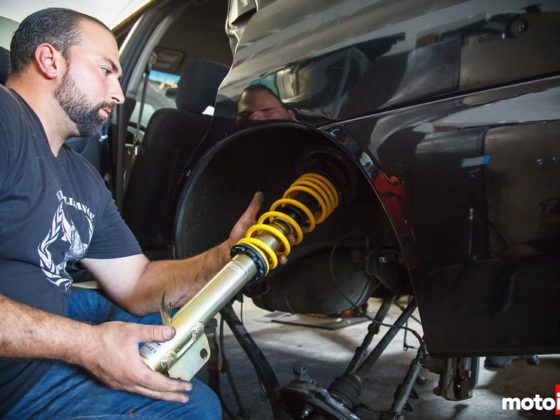Power to go! There are times when all of us want electricity when we are miles from the nearest electrical outlet. Two key components to having power on the go are a mobile digital power inverter and then a battery. Ideally, a deep cell battery will handle the constant drain and recharge that you’re going to be subjecting it to.

What motivated us to investigate this DIY project was the desire to have an ongoing electric power supply in the event of a complete system outage. Though the want to stay connected while on-the-go was also a motivating factor. Whether your electric needs are driven by your desire to update your social accounts at all costs, or be able to run a small compressor to quickly pump up a flat tire during the apocalypse, you can’t deny that a mobile electric power station doesn’t sound like a great idea!
There is a wide range of solutions that will cover many short-term electric needs and requirements. Obviously many modern devices have their own battery power supply, but if you are off-grid long enough then you may need something more substantial. You can always use a small power inverter that plugs into your car’s power supply, but that puts you at risk of draining your car’s battery. That could leave you completely stranded! Depending on how far away you are from civilization it could lead to a far more difficult situation.

This article is going to show you how to make your own DIY backup power supply that is more powerful than most off the shelf units intended for small consumer orientated tasks. We wanted a short-term solution that would yield a significant amount of off-grid power for a day and, if your usage is not so significant, maybe up to a week. Of course a portable gas-powered generator is a great solution, but there are times when that may not be ideal. Or perhaps you simply want something different. In fact, add in some solar panels and that day to week range may be extended almost indefinitely. You could truly make this an off grid system.
There has been more than one occasion at the track that when we have wanted to power electric equipment. Once we got a Honda 2000W generator that solved a lot of those problems, but sometimes being a good neighbor means not running a generator. We also had another issue that was pushing me to find a solution outside of a generator. You know from the article on the DIY toddler’s wheelchair that our grandson has spinal muscular atrophy which is a challenging medical condition. He is doing quite well and is an absolute gift, but camping has been a challenge due to his medical equipment not having the battery power to sustain a whole day let alone an overnight excursion. Another concern is a simple power outage at home. For most people they usually BBQ, go out for supper, and then use flashlights or just put out some candles and wait it out, but that is not possible with a medically fragile child who needs their equipment running. Plus you cannot run a generator all night without risking the ire of everyone within hearing distance. In fact, most campgrounds have significant limitations on when you can actually run a generator. The price tag of off the shelf solutions scared me so, with the help of others plus the internet, here is my alternative power source.






16 comments
Why didn’t you use a lithium ion Car battery for a light weight solution?
Why not put everything on a movers dolly so you can wheel it around easier?
Why not use an lithium ion car battery instead of the heavy deep cycle battery?
Couldn’t you put the bin on top of a movers dolly to more easier roll the thing around instead of trying to carry it?
Hi Davin x2,
Great questions. The idea behind a deep cell battery is that it can handle the repeated draining and charging required in a setting like this. A Group 27 lithium ion battery, similar in capacity to the Group 27 battery used here, would cut the weight in half as they are just under 30 pounds. However, they cost in the neighbourhood of $1000 which is FIVE times the price of the battery used. Our choice was the best price to power ratio.
A car battery is designed to provide a huge burst of power for a short time and then be recharged by the alternator. Drain it frequently and it’s life will be shortened. A deep cell battery is designed to provide steady current over a long period of time; drained right down without shortening their lifespan. It will not work well to start your engine as it doesn’t have the cranking power.
The Group 27 is a large and obviously heavy battery and was specifically chosen for the lifespan and amount of ongoing power it would provide at the expense of weight. We knew it wouldn’t be portable. As mentioned in the article on page 3, we will be getting some castors for the case so that it can be rolled about more efficiently.
Hi there,
You mentioned solar panels. How would one go about hooking this up to solar? My son had SMA and we’d like to take him places next summer. This with solar would be perfect.
Hi Mike, I don’t know a lot about solar power but it appears to me that many solar panels have the ability to charge batteries. I will be looking into this more eventually. Sorry I cannot give you more substantial answers but I just haven’t set this up myself.
Frank
Quick crazy Question..
could i adapt this as a in car solution to not use the existing car battery? how would i charge? i guess plug in the charger to either an alternator or in to a lighter socket? Is this possible?
Hi Jeff, first sorry that I’m over a year late in responding. Second this is not a good idea as it would drain your car battery quickly thus leaving you stranded. There are low power inverter systems you can get that plug into your car lighter socket that would be a better solution – but they will drain the batter if the car is not running.
2.5 years later.
Lemme think. A typical larger 12v lead acid deep cycle battery is 100ah (or 1200 wh).
I think that lead acid batteries can use less of their total rating than a lithium battery (50% vs. 90%? something like that).
A lithium backup battery setup complete with built-in charging stuff and inverter is something about $1 / wh, so for $500-$600 you could have roughly the same setup but much more portable,etc.
I’m just not feeling the love here.
2.5 years means a lot of change in both technology and prices!
Not in the case of lithium all-in-one emergency batteries.
They’ve been at about $1 / wh all this time. It’s the sort of thing I keep track of living in a state that has regular power shutdowns in order to avoid fires. Gas generators are kind of a pain to listen to.
I’m actually kind of surprised there haven’t been big price drops, perhaps the technology is currently at a sticking point with these sizes.
Now, a really brilliant product would be to take an electric start generator, hang a good sized battery on the front of it, and cycle the generator to keep the battery full. That same battery could be used to start the gas motor when needed. All downstream power would be through the battery (and an inverter, a thing that better generators already have). There’s no point in having a gasoline engine roaring the whole time.
as an aside, the best part of plumbing a battery between a gas generator and a power consumer is that the generator could be sized to average load rather than peak.
Just as a data point, I bought a Polaroid PS600 (578wh) for $329 plus tax in October of 2019, and an Audew 220wh unit for $154 in Dec of 2018. Prices tend to jump up and down on these sorts of products.
If you can build something like that out of a cobbled together lead-acid setup, that would be cool. One advantage of homemade is that the individual pieces are replaceable if something fails plus, if you go big on components, the system is expandable. Pretty soon you are building a whole-house battery backup which is a whole ‘nother thing.
Lots of great ideas, William. For comparison, a PS600 in Canada is $1000 – if you can find one. My hope for the article was to provide some lower cost options for people who needed a short term solution. Sounds like you’ve got ideas for ongoing and long-term solutions! And I’m guessing that if you haven’t gone the whole house route, that this isn’t too far away!
Your design does not include an auto-on for your inverter. It is possible for your inverter to be turned off (unintentionally perhaps) meaning no backup if your system is unattended.
That remote switch on the Eliminator Inverter most likely has unused pins. Mine has. Two of those non-populated wire on the RJ-11 connector (black wire and white wire can host a fix SPST switch. I build a circuit that monitors the hydro and turns on the inverter is power has gone off. The circuit uses an electronic switch instead. I added a relay to switch the load from main to inverter power with hydro goes off. It returns to original when hydro comes back on. I like your choice of AGM batteries and multi-stage charger.
Hi Ray, that is more complex than I needed but certainly extends the functionality. In my case, we are always present when running the inverter. And as it’s an RV that is usually ‘boondocking’, there’s no electrical connection to shore power when the inverter is in use. Thanks for making me think about possible expansion routes!
Frank